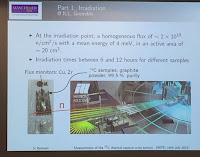#UNTF2019 continues today after yesterday's talks, poster session, and conference dinner, with two sessions in the morning, followed by the end of the conference and lunch. Here's a summary of the first session's first two talks (with the third being designated for attendees-eyes only)
The second talk had the title "Robots used to mitigate nuclear disasters", with a discussion of exactly that -- how robots can be made and used in nuclear disasters. They need to be very radiation-resistant, for examples, which has consequences for the design. Also, you can't go in and fix it if it has a small problem, so it has to be very reliable. Ideally you'd like to communicate with it wirelessly, but nuclear reactors tend to be heavily shielded. The environment (radiation aside) can be pretty hazardous; flooding, fallen masonry etc. All-in-all, quite a challenge to the robot builder. We had
The talk covers robots used historically; the "RadRobot", "RedBot", and "WorkHorse" used at Three Mile Island; At Chernobyl there is a museum dedicated to the robots used there, though full details of the ~60 robots used there have been lost. The most succssful robot used there, "MoBot" was destroyed when a helicopter accidentally dropped it. Some robots used, such as converted tanks and bulldozers, broke down very quickly due to the environmental hazards. Some years after the initial disaster further more advanced robots were sent in to assess the continuing status of the ruined reactor; The robots used at Three Mile Island and Chernobyl were built reactively after the disasters, while in Fukushima there were a number of robots built in advance to be used in case of problems (as well as to routinely monitor). Unfortunately, they were not very usable in Fukushima because the robot projects had been defunded and the robots left in cupboards, lacking maintenance, and lacking expertise of the staff who had left or moved on to other projects. Instead, "Packbots" and "Warrier" robots were bought off the shelf from the US and deployed. They weren't radiation-hardened but were well-developed in other technological areas. Many other robots were then deployed -- e.g. the "quince" which could go up stairs and over rubble, the "RaBot", a radiation-hardened robot which could handle very high radiation doses (10,000 Sv per hour).
The talk ended with a couple of robots designed for the future; Honda's E2-DR and the Centauro from Italy. We were treated to a video of the E2-DR which looks a little like it's trying to get back from a conference dinner after one too many drinks:
Toby Wright from Manchester started the morning with a comprehensive survey of all kinds of nuclear data being collected at the n_TOF (neutron time-of-flight) facility at CERN. This includes things like neutron absorption cross sections and fission data, which provide useful input for applications - particularly nuclear reactors. Toby presented a lot of results of data, improving on older measurements and evaluations
The second talk had the title "Robots used to mitigate nuclear disasters", with a discussion of exactly that -- how robots can be made and used in nuclear disasters. They need to be very radiation-resistant, for examples, which has consequences for the design. Also, you can't go in and fix it if it has a small problem, so it has to be very reliable. Ideally you'd like to communicate with it wirelessly, but nuclear reactors tend to be heavily shielded. The environment (radiation aside) can be pretty hazardous; flooding, fallen masonry etc. All-in-all, quite a challenge to the robot builder. We had
The talk covers robots used historically; the "RadRobot", "RedBot", and "WorkHorse" used at Three Mile Island; At Chernobyl there is a museum dedicated to the robots used there, though full details of the ~60 robots used there have been lost. The most succssful robot used there, "MoBot" was destroyed when a helicopter accidentally dropped it. Some robots used, such as converted tanks and bulldozers, broke down very quickly due to the environmental hazards. Some years after the initial disaster further more advanced robots were sent in to assess the continuing status of the ruined reactor; The robots used at Three Mile Island and Chernobyl were built reactively after the disasters, while in Fukushima there were a number of robots built in advance to be used in case of problems (as well as to routinely monitor). Unfortunately, they were not very usable in Fukushima because the robot projects had been defunded and the robots left in cupboards, lacking maintenance, and lacking expertise of the staff who had left or moved on to other projects. Instead, "Packbots" and "Warrier" robots were bought off the shelf from the US and deployed. They weren't radiation-hardened but were well-developed in other technological areas. Many other robots were then deployed -- e.g. the "quince" which could go up stairs and over rubble, the "RaBot", a radiation-hardened robot which could handle very high radiation doses (10,000 Sv per hour).
The talk ended with a couple of robots designed for the future; Honda's E2-DR and the Centauro from Italy. We were treated to a video of the E2-DR which looks a little like it's trying to get back from a conference dinner after one too many drinks:







